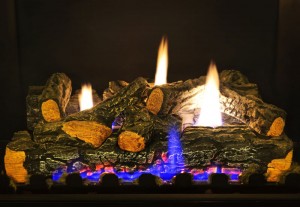The thought of converting a traditional fireplace to gas may border on blasphemy for some fireplace purists. You can liken it to vinyl records—as the needle strikes the vinyl, there’s a faint hiss, as though the record player were a hotplate, with music notes sizzling in place of bacon and eggs. Then, a voice, sounding as clear and packed with raw feeling as the day the song was recorded decades ago, begins to emerge. The audio is not just crisp, but also warm and all-encompassing. You can still dust off those old 45s, of course, but why would you when there are comparable, more efficient and convenient products on the market.
A traditional fireplace requires chopping and carrying wood, arranging the logs in the fireplace to build the fire, and cleaning up the ashes. A gas fireplace, on the other hand, requires little more than pushing a button while eliminating the need to clean up ashes. In a world of instant coffees and instant foods, instant flames were sure to follow. We’re here to help you decide which gas heating option is right for you.
Available Gas Fireplace Heating Options
When considering making the switch, you will have three possible options: direct vent gas insert, unvented gas logs (also referred to as either room-vented or vent-free), and vented gas logs. The following chart can help you determine which option is right for you:
($2,000-$4,000) Direct Vent Gas Insert
($100-$1,200) Unvented Gas Logs
($100-$1,200) Vented Gas LogsIncreases heat output: Yes Yes No
Adds excess moisture to your home: No Yes No
Restrictions on recommended length of continuous use: No Yes No
Stops cold drafts: Yes Yes No
Uses only outside air for combustion: Yes No No
Endorsed by the American Lung Association: Yes No No
Legal in all 50 states: Yes No Yes
Of the three, the direct vent gas insert is by far the most energy efficient (not to mention it’s safer, provides more heat, and most closely replicates the experience of wood-burning without the mess). The additional safety features and energy efficiency comes with a greater initial expense. This additional upfront investment will be recouped over time through decreased heating and cooling bills.
Gas Fireplace Considerations
No matter which option you choose, however, there are some important things to consider. Check with your local government to determine the necessary permits, applicable fees, requirements, and restrictions. Remember to have all work involving the actual gas lines themselves done by a licensed professional. Purchase the manufacturer’s recommended log set/insert for your space. Always follow the manufacturer’s scheduled maintenance and inspection recommendations to ensure you get the most out of your investment. Keeping these considerations in mind will help to provide you with the best opportunity to rekindle the love you once had for your fireplace.
Convenience is leading more people to convert wood-burning fireplaces to gas. People are looking to get away from doing the additional work associated with wood-burning fireplaces. They want to make things easier. Gas fireplaces are easy to start, easy to stop, relatively maintenance-free, and because they offer the presence of actual flames, they give you a very convincing wood-burning aesthetic without all the fuss. It’s really the best of both worlds. This conversion will likely provide you with more free time, as it will relieve you of your wood hauling, cutting, stacking, and carrying duties. What will you do with your newfound chunk of time?

